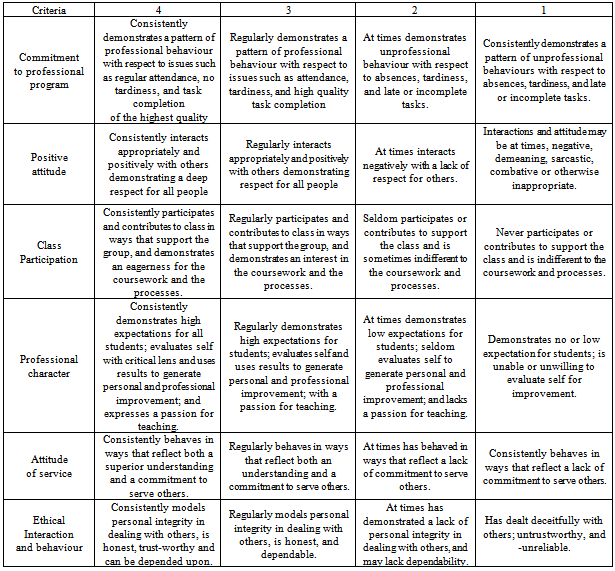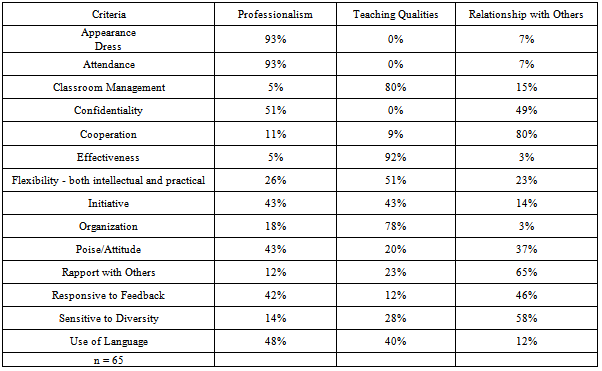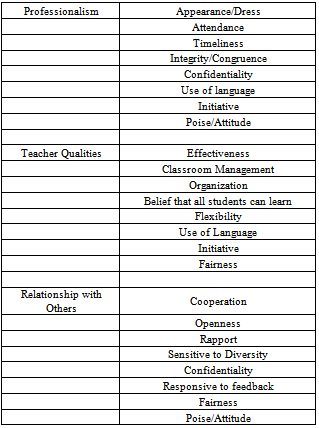Ann P. Bradley 1, JoAnn Jurchan 2
1Teacher Education Department, School of Education, Azusa Pacific University, Orange, CA 92868, USA
2Teacher Education Department, School of Education, Azusa Pacific University, San Diego, CA 92108, USA
Correspondence to: Ann P. Bradley , Teacher Education Department, School of Education, Azusa Pacific University, Orange, CA 92868, USA.
| Email: |  |
Copyright © 2012 Scientific & Academic Publishing. All Rights Reserved.
Abstract
In 2003, Azusa Pacific University Teacher Education Department began research aimed at gauging the dispositions of their teacher credential candidates. To meet their obligation as a Christian university, an NCATE accredited School of Education, and a Teacher Credential program with the State of California, the program was directed to evaluate that teacher candidates know and can demonstrate the content knowledge, pedagogical knowledge and skills, professional knowledge and skills, and professional dispositions necessary to help all students learn. Initially the project piloted a system wide process to measure the dispositions of their teacher credential candidates based on a generic criteria set and rubric. Data was collected and analysed. However in light of conflicting research found in the literature from the field, concerns arose regarding whether the current instrument was actually measuring the appropriate critical attributes of teacher dispositions. Consequently the researchers undertook a three year project to examine on the nature of dispositions; their place and importance in the development of teacher candidates; and the challenges of following the NCATE mandate. Input was solicited from local, regional, national, and international stakeholders to initially examine an instrument developed by researchers in North Carolina. As a result of analysis of both quantitative and qualitative data, a list of essential criteria that could be used to effectively measure teacher candidate dispositions emerged. Consequently a more reliable measure of candidate dispositions is currently in use as part of a comprehensive program of using Dispositions to guide and measure teacher candidates.
Keywords:
Teacher Preparation, Teacher Dispositions, Teacher Evaluation
Cite this paper: Ann P. Bradley , JoAnn Jurchan , Dispositions in Teacher Education: Complex but Comprehensible, Education, Vol. 3 No. 1, 2013, pp. 98-104. doi: 10.5923/j.edu.20130301.13.
1. Introduction
This article will detail the journey a teacher education department undertook to effectively measure the professional dispositions of their credential candidates that are necessary to help students learn.The reasons for such a journey are multi-faceted. As a Christian university there is a strong commitment to develop ethical, responsive, and informed candidates to advance for teacher credentialing. As an NCATE (National Council for Accreditation of Teacher Education) accredited program, the School of Education is mandated to evaluate to what extent “Candidates preparing to work in schools as teachers or other school professionals know and demonstrate the content knowledge, pedagogical content knowledge and skills, pedagogical and professional knowledge and skills, and professional dispositions necessary to help all students learn.”[1]At the same time there is a need to adequately and accurately measure candidates on dimensions, skills and abilities that are integral parts of the California Standards for the Teaching Profession [2]. The CSTP is a comprehensive and cohesive framework for teacher quality in which TPEs (Teacher Performance Expectations) describe what teachers need to know and be able to do before receiving a preliminary credential. Some aspects of the CSTPs, particularly in TPE 12 – Professional, Legal, and Ethical Obligations, have been difficult to reliably measure.● Candidates for a Teaching Credential take responsibility for student academic learning outcomes.● They are aware of their own personal values and biases and recognize ways in which these values and biases affect the teaching and learning of students. They resist racism and acts of intolerance.● Candidates appropriately manage their professional time spent in teaching responsibilities to ensure that academic goals are met. They understand important elements of California and federal laws and procedures pertaining to the education of English learners, gifted students, and individuals with disabilities, including implications for their placement in classrooms.● Candidates can identify suspected cases of child abuse, neglect, or sexual harassment. They maintain a non-hostile classroom environment. They carry out laws and district guidelines for reporting such cases. ● They understand and implement school and district policies and state and federal law in responding to inappropriate or violent student behaviour.● Candidates for a Teaching Credential understand and honour legal and professional obligations to protect the privacy, health, and safety of students, families, and other school professionals. ● They are aware of and act in accordance with ethical considerations and they model ethical behaviours for students. ● Candidates understand and honour all laws relating to professional misconduct and moral fitness.While these dimensions appear self-evident in some respects, they are problematic in others. Define how personal biases affect the teaching and learning of their students? One has limited evidence from which to evaluate such a dimension. How does one act “in accordance with ethical considerations and model ethical behaviour to students”? Responses may differ radically yet as an institution is called upon to make measurements and predictions to the best of their ability.
2. Study Development
An initial set of observable behaviours indicative of the requisite dispositions were identified and a rubric was developed to measure those dispositions on a four point scale. Based on a four point rubric with four representing consistent behaviours in alignment with the specific disposition, the first internal data collection results, shown in Table 1, indicated that a majority of students were meeting the standards that had been articulated. Table 1. Fall 2008 Student Dispositions Rubric Score Results
 |
| |
|
Despite the strong results evidenced in the initial data, the department continued to struggle with several issues from which a subsequent objective emerged – to determine if whatwas being done to measure dispositions was credibly informed by research in the field. An extensive review of the literature was undertaken at that time to broaden perspectives and knowledge of how others might approach the problem.What was uncovered was that this area of study is not without controversy[3]. Some of the research points to the presumption that there is a connection between teacher dispositions and the consequent development of student dispositions wherein the teacher acts as the exemplar[4]. Moreover, that there is something unique about teaching and “teacher” that extends beyond the acquisition of knowledge, pedagogy, and skill development requisite for job performance[5].A cautionary stance for the consideration of disposition as part of teacher evaluation is that this implies a role of teacher preparation programs as “gatekeepers” ultimately determining who should be entitled to teach. Furthermore, critics of the inclusion of disposition as part of an assessment and accountability aspect of teacher education candidates deem disposition although not entirely useless, to be a “superfluous construct in teacher education”[6].Additionally, while there may be a connection between teacher behaviour and expectations, to propose or assume a causal relationship between teacher behaviour and that which was the catalyst for the behaviour - disposition - is beyond the scope of current research.Apparent in the literature is the absence of not only an agreed upon definition of disposition but an operational definition as it pertains to teacher identity or teacher characteristics. Flowers describes disposition as multidimensional consisting of professionalism, teaching quality, and relationship with others[7],[8]. Villegas defines dispositions as tendencies for individuals to act in a particular manner under certain circumstances based on their beliefs[11]. However, there is common ground amongst several engaged in disposition research and that is that disposition consists of traits and talents that can be developed and honed; that it is a tendency towards positivity, patience, compassion, self-reflection, engaging in equitable teaching practices, and competence[14],[15].Teaching is a profession with certain moral and technical expectations[5] and disposition embodies virtues of character used to describe the practice of teaching. Ultimately, we want teachers to be practically wise[4], and it is the interdependent relationship between practical wisdom (virtue of the intellect) and virtue of character traits and dispositions that makes continued research in this area compelling.Based on the extensive literature review and continued discussion throughout the Teacher Education department, it was determined that the criteria needed to be articulated more clearly and all faculty including adjuncts received training on the use of any evaluation rubric. The revised rubric was also intended to inform teacher candidates of the importance of establishing and maintaining appropriate dispositions, Table 2. Table 2. Disposition Assessment Rubric - Student Dispositions Rating Rubric
 |
| |
|
Credential candidates received a copy and advisors reviewed and discussed the document with them face to face. At the conclusion of each course, instructors completed candidate and submitted them for review by the Program Directors. Additionally, the Dispositions Rating sheets are included in each class syllabus or on the class website so that candidates were kept aware of the expectations throughout their program. Candidates whose results indicated particular challenges were called in to meet with the Program Directors to discuss their match for the program.
3. Data Collection and Analysis
A smaller random sampling of candidates from the 2009-2010 Single Subject Credential Program was examined and results compared to the 2008 results. Table 3 shows the 2009-2010 percentages with the 2008 results directly below in Table 4 for comparison purposes. Note the rewording of the evaluation criteria. The results are still strong, and while there seems to be a consensus within the faculty that the results are more realistic, lingering concern surrounds the issue of whether this instrument yet gives the department the information they need to be proactive with students regarding the professional dispositions necessary to help all students learn. As new teachers are educated with a practical skill set for teaching, there is also the desire that they actively seek life-long learning and knowledge; cultivate an open approach to diversity and collaboration; and strive for professionalism, and personal integrity. We chose to focus on characteristics believed to shape Ethical, Responsive, and Informed teacher candidates and came to agreement on the position that certain behaviours can become reliable indicators for predictable patterns of dispositions. When dispositions are viewed as attributes of nature, character, temperament, and outlook that translate into observable behaviours, certain assumptions must be recognized to exist within this position. We accepted as true that dispositions can be developed, measured, remediated, and matured but the challenge remained to identify, classify, and finally to measure subjectively those traits that are research based and have generally accepted operational definitions. Table 3. 2009-2010 Single Subject Credential Student Dispositions Rubric Score Results
 |
| |
|
Table 4. Fall 2008 Student Dispositions Rubric Score Results
 |
| |
|
The researchers created a format to collect data from local, regional, national, and international groups and in order to examine some of the assumptions regarding teacher dispositions groups of educational leaders were asked to considered the assessment criteria from the Clinical Experience Rubric (CER), a research based instrument designed to assess pre-service dispositions in the earliest stages of professional teacher development[8]. Based on INTASC Standards, the CER is generally utilized prior to Student Teaching[12]. After a series of workshops, presentations to stakeholders, and facilitated discussion the collective data was analysed to enable the researchers to construct a more reliable instrument that incorporates the “professional dispositions necessary to help all students learn”. Table 5 shows the criteria in alpha order that are measured using the CER.Table 5. CER Criteria (alpha order)
 |
| |
|
Table 6. CER Assessment Criteria - Classified
 |
| |
|
In order to more tightly focus the exemplars of the identified attributes, data from a wider variety of stakeholder groups, including faculty members, mentor teachers, student teaching supervisors, and school district personnel the groups was solicited. Since “qualitative findings can be themes, patterns, concepts, insights, understandings”[9] groups were asked to brainstorm exemplars and classify them anchored to the themes identified in the literature. The groups were asked to classify the criteria according to three significant themes in teaching: professionalism (P), teaching qualities (TQ), and relationships with others (R). The multiple data collections were compiled and analysed. [10] Table 6 reflects their collective classifications.Based on those group discussions, additional criteria were added for consideration. Table 7 reflects the classification of these.Table 7. Additional assessment criteria
 |
| |
|
Table 8 shows all the assessment criteria arranged by the factors in rank order.Group members were then asked to articulate what that criteria “might look like in a classroom” and the information they provided was utilized to create operational definitions of each of the criteria. Table 8. Assessment criteria arranged by the factors in rank order
 |
| |
|
Table 9. Dispositions - Exemplars
 |
| |
|
4. Program Overview
The combination of quantitative and qualitative methods provided us with formative information to use in program improvement and evaluation.[15] The subsequent redesign moved us to a developmental approach that provides both maximized support for our students and ethical gatekeeping for the profession. Students sign off a Student Dispositions Agreement at their initial advisement into the program when advisors review the document and discuss the importance of establishing and maintaining appropriate dispositions.Additionally, the Student Dispositions Rating sheets are included in each class syllabus or the online course site for each class so students review and are kept aware of the expectations throughout their program. When dispositional“challenges” become evident in candidate behaviour, faculty have been trained to deal immediately with students through one to one conferencing to develop a remediation/intervention plan. At the conclusion of each course, instructors rank each student on how well they have met program expectations and submit student ratings on every student to their appropriate Program Director. Program directors monitor quarterly results across their programs for behavioural trends and problem spots and meet with students for whom remediation has been unsuccessful.
5. Future Study Recommendations
●Partner directly with schools to examine new teacher dispositions/behaviours anticipating that teacher evaluation processes are moving to capture similar data for challenged or unsuccessful teachers.●Expand work with existing administrators to collect data on their expectations and current findings in order to research additional implications for school improvement and student success. ●University wide implementation for faculty employment, promotion, and evaluation. (already inprocess)●Develop tools for use with additional screening at initial advisement for new candidates.●Partnerships with other IHE to develop programs / processes/procedures for faculty and students.
6. Conclusions
The comprehensive use of this dispositional process allows us:1. To educate our candidates on the behavioural expectations of the field; 2. Encourage and support students early and throughout their preparation, and 3. In some cases has given us the data to counsel inappropriate students out of the program.As institutions continue to consider that if “certain behaviours are reliable indicators for predictable patterns of desired dispositions”- the question of how these indicators can be measured will continue to be asked. This study provides a model for how institutions can advance as they struggle with the issues of measuring attributes like fairness, a belief that all students can learn, personal integrity, congruence in word and deed, as well as openness.
ACKNOWLEDGEMENTS
The authors wish to acknowledge the contributions of the faculty and leadership of the Teacher Education Department of Azusa Pacific University, specifically the chair, Dr. Greg Kaiser and former chair, Dr. Chinaka DomNwauchkuswu.
References
| [1] | National Council for Accreditation of Teacher Education. (2008). “Professional Standards for the Accreditation of Schools, Colleges, and Departments of Education”, Washington, DC: Author |
| [2] | California Standards for the Teaching Profession (CSTPs), California Commission on Teacher Education: California Department of Education, 1997. |
| [3] | Diez, M., and Raths, J. (Eds.), Dispositions in Teacher Education, Information Age Publishing, Charlotte: NC, 2007. |
| [4] | Osguthorpe, R., “On the Reasons We Want Teachers of Good Disposition and Moral Character”, Journal of Teacher Education, 2008; 59; 4, pp. 288-299. |
| [5] | Darling-Hammond, L., “Constructing 21st-Century Teacher Education”, Journal of Teacher Education,2006; 57; pp. 300-314. |
| [6] | Murray, F., “Disposition: A Superfluous Construct in Teacher Education”, Journal of Teacher Education, 2007; 58; 5, pp.381-387. |
| [7] | Flowers, C., “Confirmatory Factor Analysis of Scores on the Clinical Experience Rubric: A Measure of Dispositions for Preservice Teachers”, Educational and Psychological Measurement, 2006; 66; pp. 478-488. |
| [8] | Rebich, S., & Hopper, C. (2004, February). Clinical rubrics: An integral part of teacher candidate assessment. Paper presented at the annual meeting of the Association of Teacher Educators, Dallas, TX. |
| [9] | Patton, M. Qualitative research and evaluation methods (3rd. ed.). Thousand Oaks, CA: Sage, 2002. |
| [10] | Coffey, A. & Atkinson, P. Making sense of qualitative data: Complementary research strategies. Thousand Oaks, CA: Sage, 1996. |
| [11] | Villegas, A. “Dispositions in Teacher Education: A Look at Social Justice”, Journal of Teacher Education, 2007; 58; 5, pp. 370-380. |
| [12] | Grant, C. A., and Gillette, M., “A Candid Talk to Teacher Educators about Effectively Preparing Teachers Who Can Teach Everyone’s Children”, Journal of Teacher Education, 2006; 57; 3, pp. 292-299. |
| [13] | Talbert-Johnson, C., “Preparing Highly Qualified Teacher Candidates for Urban Schools: The Importance of Dispositions”, Education and Urban Society, 2006; 39; pp.147-160. |
| [14] | Council of Chief State School Officers. (2011, April). Interstate Teacher Assessment and Support Consortium (InTASC) Model Core Teaching Standards: A Resource for State Dialogue. Washington, DC: Author. |
| [15] | Kushner, S. Personalizing evaluation. Thousand Oaks, CA: Sage, 2000. |

 Abstract
Abstract Reference
Reference Full-Text PDF
Full-Text PDF Full-text HTML
Full-text HTML







